Attribution of the Extreme Drought in the Horn of Africa during Short-Rains of 2016 and Long-Rains of 2017
Abstract
:1. Introduction
2. Data and Methodology
2.1. Study Area
2.2. Observation and Reanalysis Datasets
2.3. Meterological Drought Indices
2.4. Generalized Extreme Value (GEV) Distribution
3. Results
3.1. Climatological Background
3.2. Characteristics of Long-Term Trends in Drought of HOA
3.3. Analysis of Attribution of Extreme Drought in 2016/2017
4. Discussion
5. Conclusions
Author Contributions
Funding
Institutional Review Board Statement
Informed Consent Statement
Data Availability Statement
Acknowledgments
Conflicts of Interest
References
- Intergovernmental Panel on Climate Change (IPCC). Summary for Policymakers. In Climate Change 2021: The Physical Science Basis. Contribution of Working Group I to the Sixth Assessment Report of the Intergovernmental Panel on Climate Change; Masson-Delmotte, V., Zhai, P., Pirani, A., Connors, S.L., Péan, C., Berger, S., Caud, N., Chen, Y., Goldfarb, L., Gomis, M.I., et al., Eds.; Cambridge University Press: Cambridge, UK, 2021; in press. [Google Scholar]
- Intergovernmental Panel on Climate Change (IPCC). Summary for Policymakers. In Global Warming of 1.5 °C: An IPCC Special Report on the Impacts of Global Warming of 1.5 °C above Pre-Industrial Levels and Related Global Greenhouse Gas Emission Pathways, in the Context of Strengthening the Global Response to the Threat of Climate Change, Sustainable Development, and efforts to Eradicate Poverty; Masson-Delmotte, V., Zhai, P., Pörtner, H.-O., Roberts, D., Skea, J., Shukla, P.R., Pirani, A., Moufouma-Okia, W., Péan, C., Pidcock, R., et al., Eds.; Cambridge University Press: Cambridge, UK, 2018; in press. [Google Scholar]
- Coumou, D.; Rahmstorf, S. A decade of weather extremes. Nat. Clim. Chang. 2012, 2, 491–496. [Google Scholar] [CrossRef]
- Trenberth, K.E.; Fasullo, J.T.; Shepherd, T.G. Attribution of climate extreme events. Nat. Clim. Chang. 2015, 5, 725–730. [Google Scholar] [CrossRef]
- Diffenbaugh, N.S.; Singh, D.; Mankin, J.S.; Horton, D.E.; Swain, D.L.; Touma, D.; Charland, A.; Liu, Y.; Haugen, M.; Tsiang, M.; et al. Quantifying the influence of global warming on unprecedented extreme climate events. Proc. Natl. Acad. Sci. USA 2017, 114, 4881–4886. [Google Scholar] [CrossRef] [PubMed] [Green Version]
- Hao, Z.; Hao, F.; Singh, V.P.; Ouyang, W.; Zhang, X.; Zhang, S. A joint extreme index for compound droughts and hot extremes. Theor. Appl. Climatol. 2020, 142, 321–328. [Google Scholar] [CrossRef]
- Seneviratne, S.; Nicholls, N.; Easterling, D.; Goodess, C.; Kanae, S.; Kossin, J.; Luo, Y.; Marengo, J.; McInnes, K.; Rahimi, M.; et al. Changes in climate extremes and their impacts on the natural physical environment. In Managing the Risks of Extreme Events and Disasters to Advance Climate Change Adaptation: A Special Report of Working Groups I and II of the Intergovernmental Panel on Climate Change (IPCC); Field, C.B., Barros, V., Stocker, T.F., Qin, D., Dokken, D., Ebi, K.L., Mastrandrea, M.D., Mach, K.J., Plattner, G.-K., Allen, S.K., et al., Eds.; Cambridge University Press: Cambridge, UK, 2012; pp. 109–230. [Google Scholar]
- Zscheischler, J.; Westra, S.; Van Den Hurk, B.J.; Seneviratne, S.I.; Ward, P.J.; Pitman, A.; AghaKouchak, A.; Bresch, D.N.; Leonard, M.; Wahl, T.; et al. Future climate risk from compound events. Nat. Clim. Chang. 2018, 8, 469–477. [Google Scholar] [CrossRef]
- Kiem, A.S.; Johnson, F.; Westra, S.; Van Dijk, A.; Evans, J.; O’Donnell, A.; Rouillard, A.; Barr, C.; Tyler, J.; Thyer, M.; et al. Natural hazards in Australia: Droughts. Clim. Chang. 2016, 139, 37–54. [Google Scholar] [CrossRef]
- Livneh, B.; Hoerling, M.P. The Physics of Drought in the U.S. Central Great Plains. J. Clim. 2016, 29, 6783–6804. [Google Scholar]
- Shukla, S.; Safeeq, M.; AghaKouchak, A.; Guan, K.; Funk, C. Temperature impacts on the water year 2014 drought in California. Geophys. Res. Lett. 2015, 42, 4384–4393. [Google Scholar] [CrossRef] [Green Version]
- Conway, D.; Schipper, E.L.F. Adaptation to climate change in Africa: Challenges and opportunities identified from Ethiopia. Glob. Environ. Chang. 2011, 21, 227–237. [Google Scholar] [CrossRef]
- Ghebrezgabher, M.G.; Yang, T.; Yang, X. Remote sensing and GIS analysis of deforestation and desertification in central highland and eastern region of Eritrea (1972–2014). Int. J. Sci. Basic Appl. Res. 2014, 18, 161–176. [Google Scholar]
- Lyon, B. Seasonal drought in the greater horn of Africa and its recent increase during the March–May long rains. J. Clim. 2014, 27, 7953–7975. [Google Scholar] [CrossRef]
- Beltrando, G. Space–time variability of rainfall in April and October–November over East Africa during the period 1932–1983. Int. J. Climatol. 1990, 10, 691–702. [Google Scholar] [CrossRef]
- Camberlin, P.; Wairoto, J.G. Intraseasonal wind anomalies related to wet and dry spells during the ‘‘long’’ and ‘‘short’’rainy seasons in Kenya. Theor. Appl. Climatol. 1997, 58, 57–69. [Google Scholar] [CrossRef]
- Lyon, B.; DeWitt, D.G. A recent and abrupt decline in the East African long rains. Geophys. Res. Lett. 2012, 39, L02702. [Google Scholar] [CrossRef] [Green Version]
- Salami, A.; Kamara, A.B.; Brixiova, Z. Smallholder Agriculture in East Africa: Trends, Constraints, and Opportunities; African Development Bank Working Papers Series No. 105; African Development Bank: Tunis, Tunisia, 2010; p. 52. Available online: http://www.afdb.org/fifileadmin/uploads/afdb/Documents/Publications/WORKING%20105%20%20PDF%20d.pdf (accessed on 15 September 2021).
- Human Rights Watch. Evil Days: 30 Years of War and Famine in Ethiopia; An Africa Watch Report; Human Rights Watch: New York, NY, USA, 1991. [Google Scholar]
- Allen, C.D.; Macalady, A.K.; Chenchouni, H.; Bachelet, D.; McDowell, N.; Vennetier, M.; Cobb, N. A global overview of drought and heat-induced tree mortality reveals emerging climate change risks for forests. For. Ecol. Manag. 2010, 259, 660–684. [Google Scholar] [CrossRef] [Green Version]
- Abdulkadir, G. Assessment of drought recurrence in Somaliland: Causes, impacts and climatology. J. Climatol. Weather. Forecast. 2017, 5, 2. [Google Scholar] [CrossRef] [Green Version]
- Devereux, S. Famine in the Twentieth Century; IDS Working Paper 105; Institute of Development Studies, University of Sussex: Brighton, UK, 2000; p. 40. [Google Scholar]
- United Nations Organization for the Coordination of Humanitarian Affairs (UN OCHA). Eastern Africa Drought; Humanitarian Rep. 4; United Nations Organization for the Coordination of Humanitarian Affairs: New York, NY, USA, 2011; p. 10. [Google Scholar]
- Tran, M. Explainer: The East Africa Food Crisis. Guardian, 12 July 2011. [Google Scholar]
- Checchi, F.; Robinson, W.C. Mortality among Populations of Southern and Central Somalia Affected by Severe Food Insecurity and Famine during 2010–2012; Food and Agriculture Organization (FAO); Famine Early Warning Systems Network (FEWS NET): Rome, Italy, 2013; p. 87. [Google Scholar]
- Loewenberg, S. Humanitarian response inadequate in Horn of Africa crisis. Lancet 2011, 378, 555–558. [Google Scholar] [CrossRef]
- Musei, S.K.; Nyaga, J.M.; Dubow, A.Z. SPEI-based spatial and temporal evaluation of drought in Somalia. J. Arid. Environ. 2021, 184, 104296. [Google Scholar] [CrossRef]
- Nicholson, S.E. A detailed look at the recent drought situation in the Greater Horn of Africa. J. Arid Environ. 2014, 103, 71–79. [Google Scholar] [CrossRef]
- Dutra, E.; Magnusson, L.; Wetterhall, F.; Cloke, H.L.; Balsamo, G.; Boussetta, S.; Pappenberger, F. The 2010-2011 drought in the Horn of Africa in ECMWF reanalysis and seasonal forecast products. Int. J. Clim. 2013, 33, 1720–1729. [Google Scholar] [CrossRef] [Green Version]
- United Nations Organization for World Food Programme (UN WFP). Kenya Drought Situation Report—January 2017. Available online: https://www.wfp.org/publications/wfp-kenya-drought-situation-report-jan-2017 (accessed on 13 January 2022).
- United Nations Disaster Risk Reduction (UN DRR). The Drought in Kenya, 2016–2017. 2017. Available online: https://www.preventionweb.net/publications/view/53538 (accessed on 13 January 2022).
- Kinuthia, J.H. Horizontal and vertical structure of the Lake Turkana jet. J. Appl. Meteorol. 1992, 31, 1248–1274. [Google Scholar] [CrossRef] [Green Version]
- Hebrezgabher, M.G.; Yang, T.; Yang, X. Long-Term Trend of Climate Change and Drought Assessment in the Horn of Africa. Adv. Meteorol. 2016, 2016, 12–13. [Google Scholar]
- Schneider, U.; Becker, A.; Finger, P.; Meyer-Christoffer, A.; Ziese, M.; Rudolf, B. GPCC’s new land surface precipitation climatology based on quality-controlled in situ data and its role in quantifying the global water cycle. Theor. Appl. Climatol. 2014, 115, 15–40. [Google Scholar] [CrossRef] [Green Version]
- Hersbach, H.; Bell, B.; Berrisford, P.; Biavati, G.; Horányi, A.; Muñoz Sabater, J.; Nicolas, J.; Peubey, C.; Radu, R.; Rozum, I.; et al. ERA5 Monthly Averaged Data on Pressure Levels from 1979 to Present. Copernicus Climate Change Service (C3S) Climate Data Store (CDS). 2019. Available online: https://doi.org/10.24381/cds.6860a573 (accessed on 13 January 2022). [CrossRef]
- Palmer, W.C. Meteorological Drought Research Paper; U.S. Department of Commerce Weather Bureau: Washington, DC, USA, 1965; p. 45.
- Hayes, M.J.; Svoboda, M.D.; Wiihite, D.A.; Vanyarkho, O.V. Monitoring the 1996 drought using the standardized precipitation index. Bull. Am. Meteorol. Soc. 1999, 80, 429–438. [Google Scholar] [CrossRef] [Green Version]
- Narasimhan, B.; Srinivasan, R. Development and evaluation of Soil Moisture Deficit Index (SMDI) and Evapotranspiration Deficit Index (ETDI) for agricultural drought monitoring. Agric. For. Meteorol. 2005, 133, 69–88. [Google Scholar] [CrossRef]
- Hao, Z.; AghaKouchak, A. Multivariate standardized drought index: A parametric multi-index model. Adv. Water Resour. 2013, 57, 12–18. [Google Scholar] [CrossRef] [Green Version]
- Rajsekhar, D.; Singh, V.P.; Mishra, A.K. Multivariate drought index: Aninformation theory based approach for integrated drought assessment. J. Hydrol. 2015, 526, 164–182. [Google Scholar] [CrossRef]
- Cammalleri, C.; Micale, F.; Vogt, J. A novel soil moisture based drought severity index (DSI) combining water deficit magnitude and frequency. Hydrol. Processes 2016, 30, 289–301. [Google Scholar] [CrossRef] [Green Version]
- Vicente-Serrano, S.M.; Beguería, S.; Lorenzo-Lacruz, J.; Camarero, J.J.; Lopez-Moreno, J.I.; Azorin-Molina, C.; Sanchez-Lorenzo, A. Performance of drought indicesfor ecological, agricultural, and hydrological applications. Earth Interact. 2012, 16, 1–27. [Google Scholar] [CrossRef] [Green Version]
- Thornthwaite, C.W. An approach toward a rational classification of climate. Geograph. Rev. 1948, 38, 55–94. [Google Scholar] [CrossRef]
- Vicente-Serrano, S.M.; Beguería, S.; Lòpez-Moreno, J.I. A multiscalar drought index sensitive to global warming: The standardized precipitation evapotranspiration index. J. Clim. 2010, 23, 1696–1718. [Google Scholar] [CrossRef] [Green Version]
- McKee, T.B.; Doesken, N.J.; Kleist, J. The relationship of drought frequency and duration to time scales. In Proceedings of the 8th Conference on Applied Climatology, Anaheim, CA, USA, 17–22 January 1993; Volume 17, pp. 179–183. [Google Scholar]
- Ying, A.; Pandey, M.D. The r largest order statistics model for extreme wind speed estimation. J. Wind Eng. Aerodyn. 2007, 95, 165–182. [Google Scholar]
- Kharin, V.V.; Zwiers, F.W.; Zhang, X.; Wehner, M. Changes in temperature and precipitation extremes in the CMIP5 ensemble. Clim. Chang. 2013, 119, 345–357. [Google Scholar]
- El Adlouni, S.; Ouarda, T.B.M.J.; Zhang, X.; Roy, R.; Bobe, B. Generalized maximum likelihood estimators for the nonstationary generalized extreme value model. Water Resour. Res. 2007, 43, W03410. [Google Scholar] [CrossRef]
- Nicholson, S.E. A review of climate dynamics and climate variability in the Greater Horn. In The Limnology, Climatology, and Paleoclimatology of the East African Lakes; Johnson, T.C., Odada, E.O., Eds.; Routledge: Oxfordshire, UK, 1996; pp. 24–56. [Google Scholar]
- Yang, W.; Seager, R.; Cane, M.A.; Lyon, B. The annual cycle of the East African precipitation. J. Clim. 2015, 28, 2385–2404. [Google Scholar] [CrossRef] [Green Version]
- Beltrando, G.; Camberlin, P. Interannual variability of rainfall in the eastern Horn of Africa and indicators of atmospheric circulation. Int. J. Climatol. 1993, 13, 533–546. [Google Scholar] [CrossRef]
- Goddard, L.; Graham, N.E. Importance of the Indian Ocean for simulating rainfall anomalies over eastern and southern Africa. J. Geophys. Res. 1999, 104, 19099–19116. [Google Scholar] [CrossRef] [Green Version]
- Schreck, C.J.; Semazzi, F.H.M. Variability of the recent climate of eastern Africa. Int. J. Climatol. 2004, 24, 681–701. [Google Scholar] [CrossRef]
- Camberlin, P.; Okoola, R.E. The onset and cessation of the ‘‘long rains’’ in eastern Africa and their interannual variability. Theor. Appl. Climatol. 2003, 75, 43–54. [Google Scholar] [CrossRef]
- Pohl, B.; Camberlin, P. Influence of the Madden–Julian oscillation on East African rainfall. I: Intraseasonal variability and regional dependency. Quart. J. R. Meteor. Soc. 2006, 132, 2521–2539. [Google Scholar] [CrossRef] [Green Version]
- Zhang, C.J.; Liu, H.B.; Song, Y.L. Grades of Meteorological Drought; Standards Press of China: Beijing, China, 2017; p. 24. (In Chinese) [Google Scholar]
- Xing., Y.; Wang, L.; Wood, E.F.; Xing., Y.; Wang, L.; Wood, E.F. Anthropogenic Intensification of Southern African Flash Droughts as Exemplified by the 2015/16 Season. Bull. Am. Meteorol. Soc. 2018, 99, S86–S90. [Google Scholar]
- Williams, A.P.; Funk, C. A westward extension of the warm pool leads to a westward extension of the Walker circulation, drying eastern Africa. Clim. Dynam. 2011, 37, 2417–2435. [Google Scholar] [CrossRef] [Green Version]
- Yang, W.; Seager, R.; Cane, M.A.; Lyon, B. The East African long rains in observations and models. J. Clim. 2014, 27, 7185–7202. [Google Scholar] [CrossRef]
- Okoola, R.E. A diagnostic study of the eastern Africa monsoon circulation during the Northern Hemisphere spring season. Int. J. Climatol. 1999, 19, 143–168. [Google Scholar] [CrossRef]
- Pohl, B.; Camberlin, P. Intraseasonal and interannual zonal circulations over the equatorial Indian Ocean. Theor. Appl. Climatol. 2011, 104, 175–191. [Google Scholar] [CrossRef]
- Camberlin, P.; Philippon, N. The East African March–May rainy season: Associated atmospheric dynamics and predictability over the 1968–1997 period. J. Clim. 2002, 15, 1002–1019. [Google Scholar] [CrossRef]
- Nicholson, S.E. The nature of rainfall variability over Africa on time scales of decades to millennia. Global Planet. Change 2000, 26, 137–158. [Google Scholar] [CrossRef]
- Indeje, M.; Semazzi, F.H.M.; Ogallo, L.J. ENSO signals in East African rainfall seasons. Int. J. Climatol. 2000, 20, 19–46. [Google Scholar] [CrossRef]
- Black, E.; Slingo, J.; Sperber, K.R. An observational study of the relationship between excessively strong short rains in coastal East Africa and Indian Ocean SST. Mon. Weather Rev. 2003, 131, 74–94. [Google Scholar] [CrossRef]
- Behera, S.; Luo, J.-J.; Masson, S.; Delecluse, P.; Gualdi, S.; Navarra, A.; Yamagata, T. Paramount Impact of the Indian Ocean Dipole on the East African Short Rains: A CGCM Study. J. Clim. 2005, 18, 4514–4530. [Google Scholar] [CrossRef] [Green Version]
- Leonard, M.; Westra, S.; Phatak, A.; Lambert, M.; van den Hurk, B.; McInnes, K.; Risbey, J.; Schuster, S.; Jakob, D.; Stafford-Smith, M. A compound event frame work for understanding extreme impacts. Wiley Interdiscip. Rev. Clim. 2014, 5, 113–128. [Google Scholar] [CrossRef]
- Kopp, R.; Easterling, D.R.; Hall, T.; Hayhoe, K.; Horton, R.; Kunkel, K.; LeGrande, A. Potential surprises–compound extremes and tipping elements. In Climate Science Special Report: Fourth National Climate Assessment; Wuebbles, D.J., Fahey, D.W., Hibbard, K.A., et al., Eds.; U.S. Global Change Research Program: Washington, DC, USA, 2017; Volume I, pp. 411–429. [Google Scholar]
- AghaKouchak, A.; Cheng, L.; Mazdiyasni, O.; Farahmand, A. Global warming and changes in risk of concurrent climate extremes: Insights from the 2014 California drought. Geophys. Res. Lett. 2014, 41, 8847–8852. [Google Scholar] [CrossRef] [Green Version]
- Hao, Z.; Hao, F.; Singh, V.P.; Zhang, X. Changes in the severity of compound drought and hot extremes over global land areas. Environ. Res. Lett. 2018, 13, 124022. [Google Scholar] [CrossRef]
- Hao, Z.; Singh, V.; Hao, F. Compound extremes in hydroclimatology: A review. Water 2018, 10, 718. [Google Scholar] [CrossRef] [Green Version]
- Tambo, J.A. Adaptation and resilience to climate change and variability in north-east Ghana. Int. J. Disaster Risk Reduct. 2016, 1785–1794. [Google Scholar] [CrossRef]
- Lott, F.C.; Christidis, N.; Stott, P.A. Can the 2011 East African drought be attributed to human-induced climate change? Geophys. Res. Lett. 2013, 40, 1177–1181. [Google Scholar] [CrossRef]
- Cook, K.H.; Vizy, E.K. Impact of climate change on mid-twenty-fifirst century growing seasons in Africa. Clim. Dyn. 2012, 39, 2937–2955. [Google Scholar] [CrossRef] [Green Version]
- Zscheischler, J.; Martius, O.; Westra, S.; Bevacqua, E.; Raymond, C.; Horton, R.M.; van den Hurk, B.; AghaKouchak, A.; Jézéquel, A.; Mahecha, M.D.; et al. LA typology of compound weather and climate events. Nat. Rev. Earth Environ. 2020, 1, 333–347. [Google Scholar] [CrossRef]
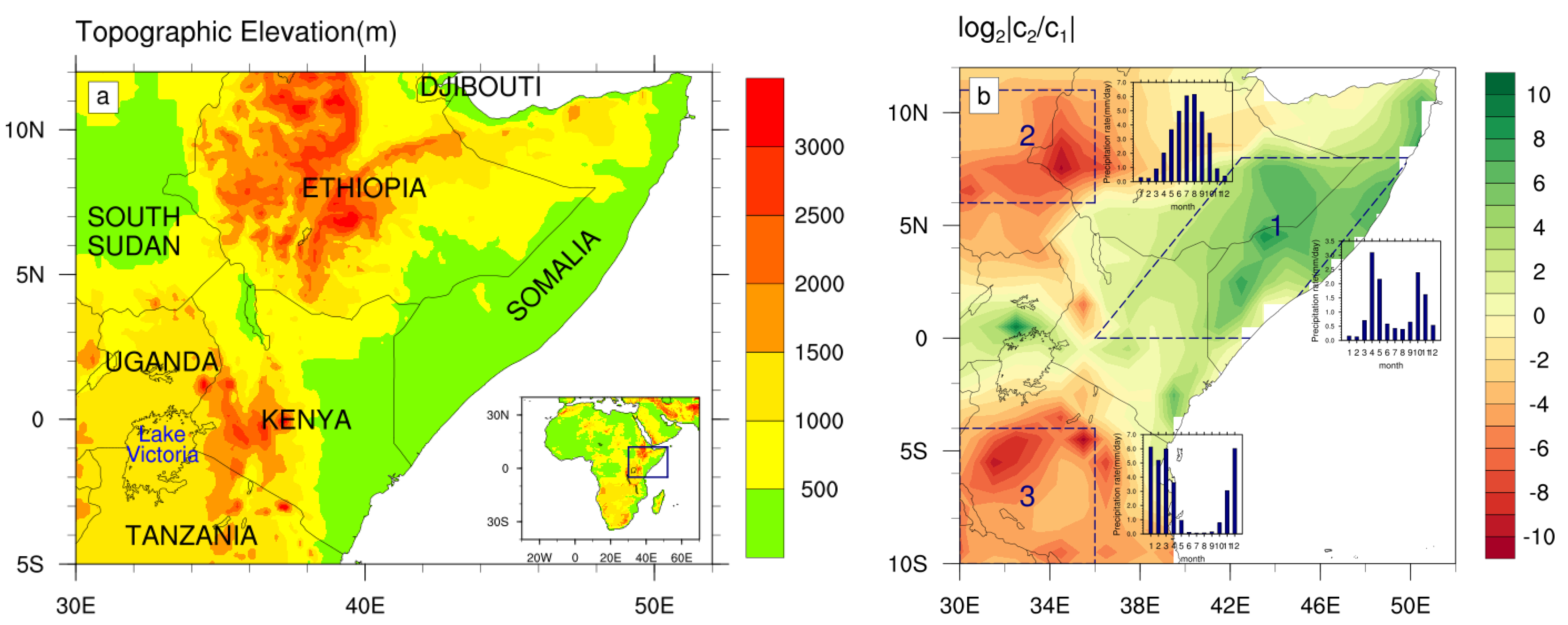
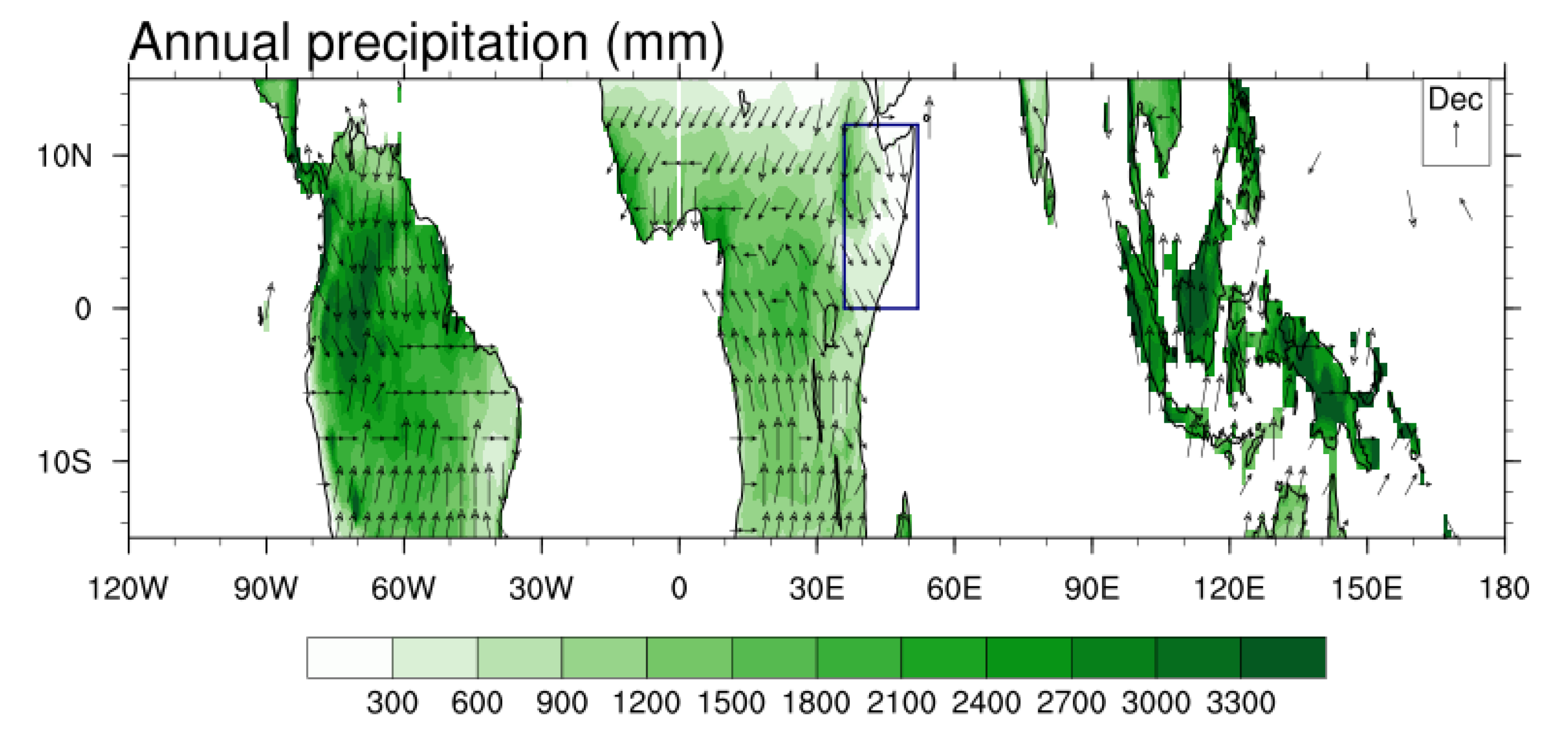
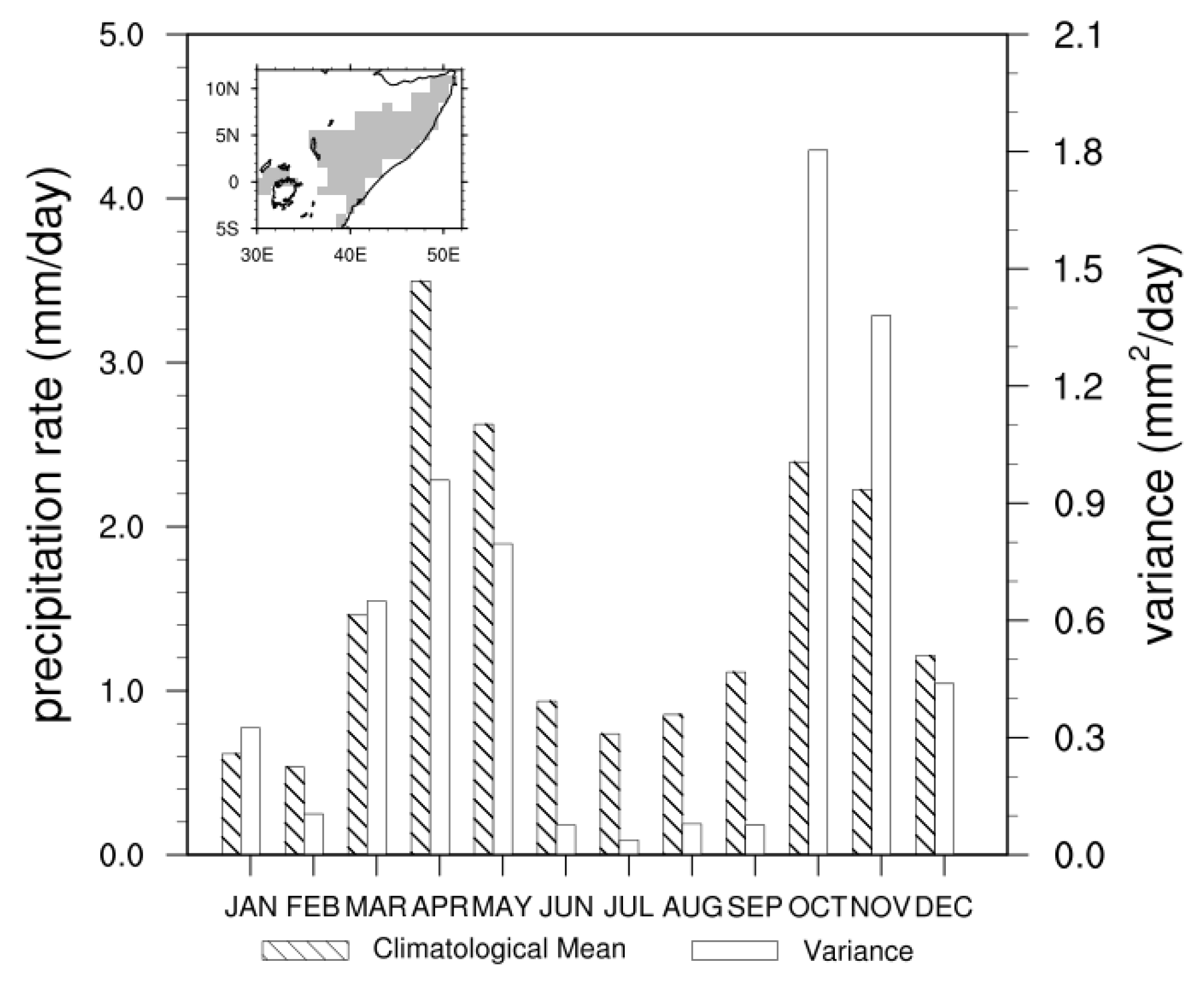
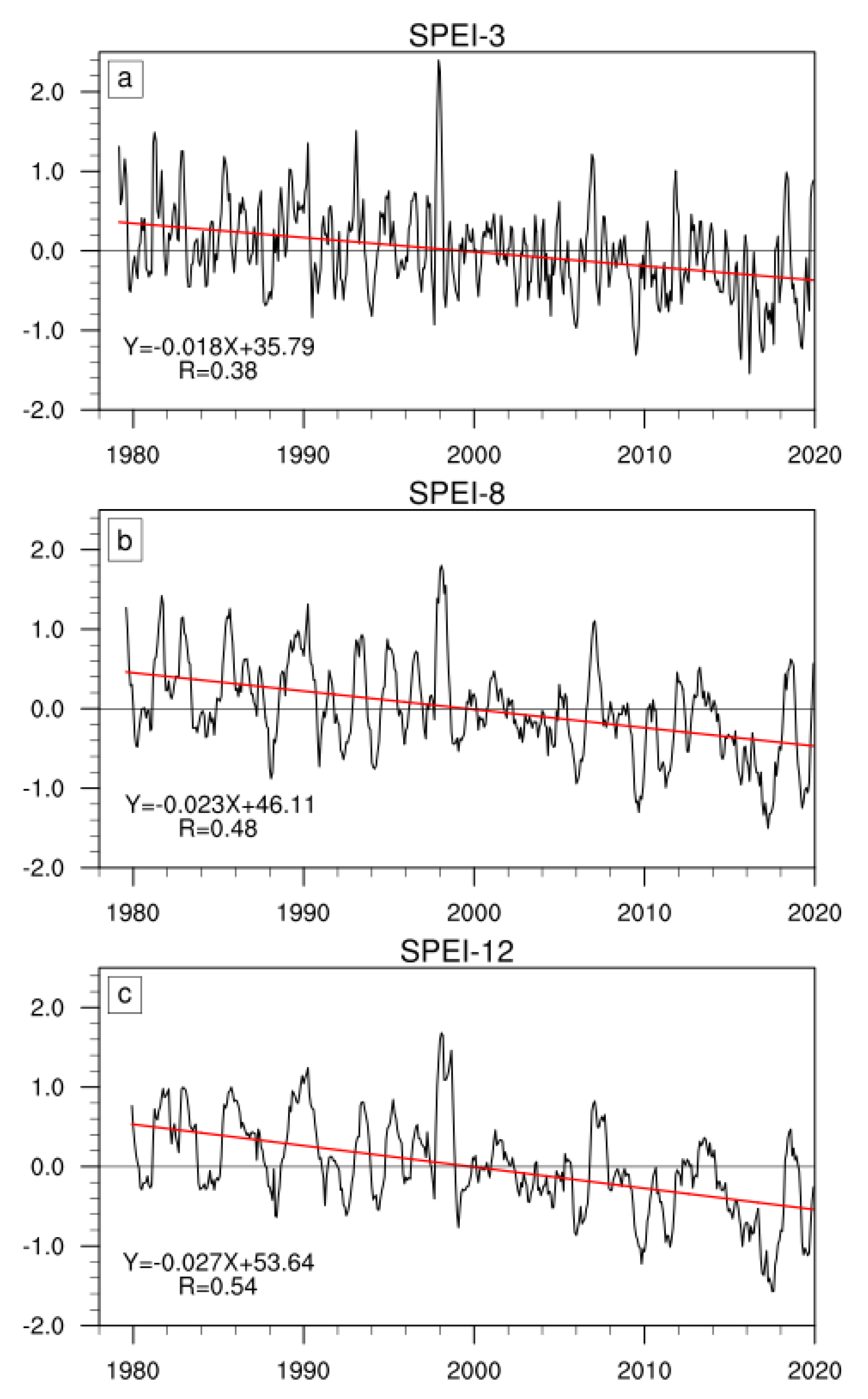

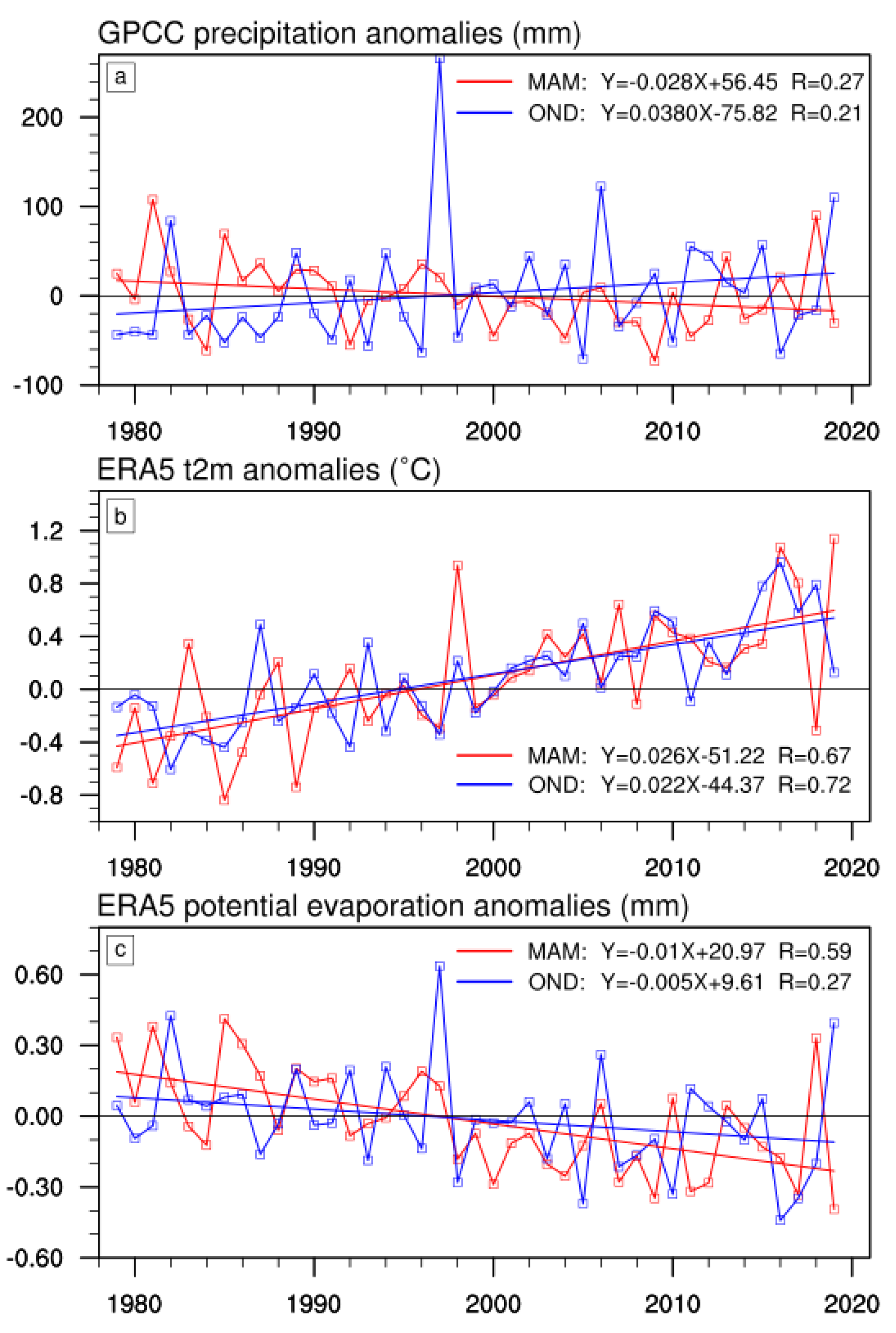
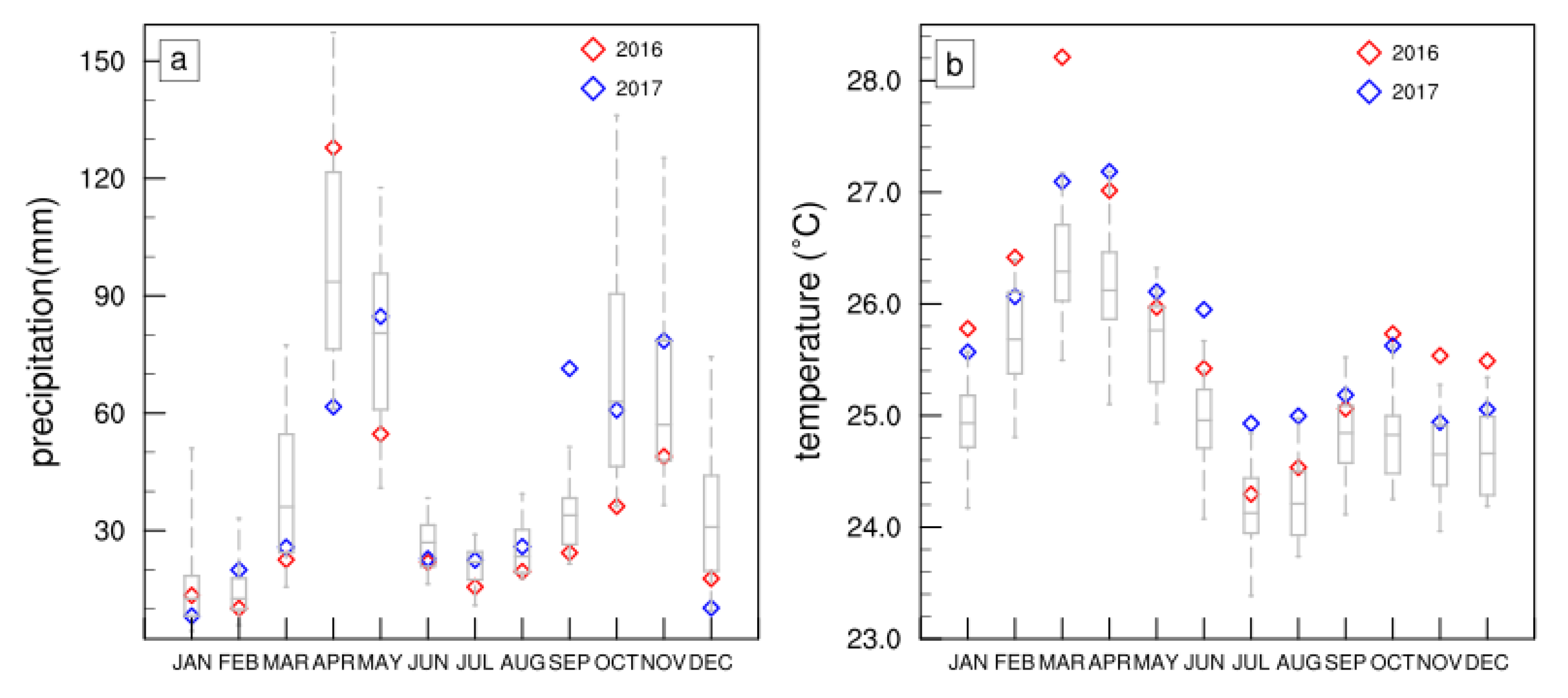
| Datasets | Horizontal Resolution | Period | |
|---|---|---|---|
| Precipitation | GPCC | 1.0° × 1.0° | 1979–2019 of (1901–2019) |
| Temperature (T2 m) | ERA5 | 0.25° × 0.25° | 1979–2019 |
| Potential evaporation (PEV) | ERA5 | 0.25° × 0.25° | 1979–2019 |
| SPEI Value | Drought Type |
|---|---|
| 0 to −0.99 | Mild drought |
| −1 to −1.49 | Moderate drought |
| −1.5 to −1.99 | Severe drought |
| ≤2.0 | Extreme drought |
| Seasonal SPEI | Precipitation | Temperature |
|---|---|---|
| MAM | 0.35 * | −0.29 |
| OND | 0.58 ** | −0.21 |
Publisher’s Note: MDPI stays neutral with regard to jurisdictional claims in published maps and institutional affiliations. |
© 2022 by the authors. Licensee MDPI, Basel, Switzerland. This article is an open access article distributed under the terms and conditions of the Creative Commons Attribution (CC BY) license (https://creativecommons.org/licenses/by/4.0/).
Share and Cite
Han, X.; Li, Y.; Yu, W.; Feng, L. Attribution of the Extreme Drought in the Horn of Africa during Short-Rains of 2016 and Long-Rains of 2017. Water 2022, 14, 409. https://doi.org/10.3390/w14030409
Han X, Li Y, Yu W, Feng L. Attribution of the Extreme Drought in the Horn of Africa during Short-Rains of 2016 and Long-Rains of 2017. Water. 2022; 14(3):409. https://doi.org/10.3390/w14030409
Chicago/Turabian StyleHan, Xue, Yan Li, Weidong Yu, and Licheng Feng. 2022. "Attribution of the Extreme Drought in the Horn of Africa during Short-Rains of 2016 and Long-Rains of 2017" Water 14, no. 3: 409. https://doi.org/10.3390/w14030409
APA StyleHan, X., Li, Y., Yu, W., & Feng, L. (2022). Attribution of the Extreme Drought in the Horn of Africa during Short-Rains of 2016 and Long-Rains of 2017. Water, 14(3), 409. https://doi.org/10.3390/w14030409





